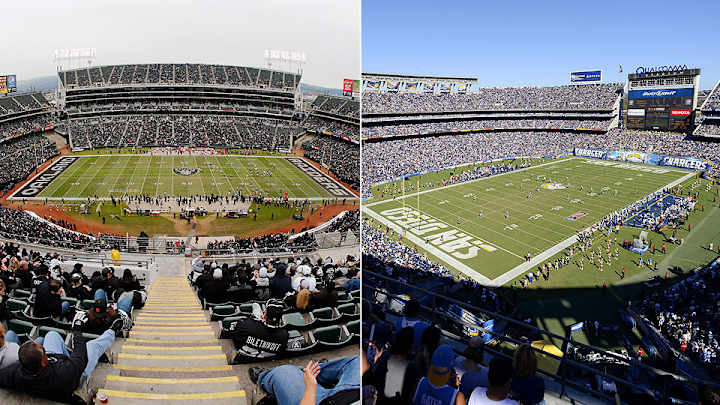As 49ers enter new home, California's other stadium issues still unsettled

The NFL has more stadium issues in California than teams. And don’t expect that to change anytime soon.
While the San Francisco 49ers have pulled off their move to Santa Clara and 68,500-seat, $1.2 billion Levi’s Stadium, the Oakland Raiders face a murky future at O.co Coliseum, the San Diego Chargers harbor hopes of building a new stadium next to the Padres’ Petco Park and just about every developer with any tie to sports has an idea for a new NFL stadium in or near Los Angeles.
Oakland
The Raiders play in the only remaining NFL stadium that is shared with a MLB team. Opened in 1966, O.co Coliseum has gained recent renown for its sewage issues and bland concrete design in a league adding cutting-edge buildings every year. The Raiders want something new, but so do the Oakland A’s. There isn’t room for them both to build new single-sport stadiums on the same site, to say nothing of the money.
While the A’s were busy finalizing a fresh 10-year lease starting in 2015 that keeps baseball in O.co, the Raiders were floating ideas of tearing down O.co in 2015 to make way for Coliseum City, a planned mixed-use development to would contain a new football-only stadium.
But with no developer on tap -- the last one pulled out earlier this year -- and a dearth of funding, Coliseum City doesn’t have much life.
Inside 49ers' new home, Levi's Stadium, a venue unlike any other
The new A’s lease does have some Raider-friendly loopholes, such as a clause that lets either party vacate the lease with a two-year notice (if the A’s leave, they still have to pay rent for the rest of the way). But with the city of Oakland unwilling to put up funds on a new stadium -- they still owe about $180 million on O.co -- it remains up to the Raiders to figure out a financing plan if they want to stay in Oakland.
The Raiders have long considered moving to Santa Clara -- it isn’t San Francisco, which may make it easier to swallow from a PR perspective. Levi’s Stadium architect Tim Cahill of HNTB Corporation tells SI.com the 49ers' new building was originally designed with two home locker rooms. The idea of sharing a home field was abandoned early on, but the space was still hard-wired in and now serves as storage for the 49ers.
But sharing a venue in Santa Clara would prove much more difficult than it does in New Jersey, where MetLife Stadium was designed and built with the knowledge that the Jets and Giants would share the facility. Levi’s Stadium has no such luxury.
The entire stadium is branded solely for the 49ers. The building itself features white steel and red accents in everything from seats to concession buildings. Remember, Levi’s Stadium sits closer than 40 feet from the 49ers’ headquarters and practice fields. The more than 500 pieces of art are 49ers-related, and the stadium holds a giant team store -- obviously those details could be changed. A brand-new 49ers museum takes up street-level space, and owner Jed York has his custom-designed suite built in. Levi’s Stadium fits the 49ers. The addition of the Raiders would feel like just that: an addition.
Los Angeles
The NFL loves Los Angeles, but without a stadium the notion of a team relocating to the area is merely fantasy. New England Patriots owner Robert Kraft's signaled the NFL's willingness to get creative in July when he floated the concept of the league building a new stadium, which would be at least a $1 billion project.
Audibles Podcast: Players we can't wait to watch in the preseason, more
An NFL-owned stadium could prove critical to any relocation bid, which would surely include a hefty fee to help pay back the stadium costs. The league may also be enticed by the possibility of hosting events such as the Pro Bowl close to NFL Network's suburban headquarters in Culver City.
In return, the NFL would need to sweeten the pot for the local team by freeing up local revenue streams in the form of sponsorships or seat licenses.
San Diego
Don’t forget about the Chargers. While San Diego is often thrown into the Los Angeles relocation discussion, the team and new city leaders will engage in talks on how to replace Qualcomm Stadium, which was built in 1967, with a new 70,000-seat venue east of Petco Park in downtown San Diego.
In order to pull together funding, the city could sell and/or develop the 166 acres that now houses Qualcomm and could also ask for a hefty contribution from the Spanos family, which owns the Chargers.
While the 49ers were able to successfully replace Candlestick Park, Oakland, San Diego and Los Angeles have 1960s-era stadium realities bumping against their dreams. Stadium sites aren’t hard to find -- it's finding the money that’s the rub.
Tim Newcomb covers stadiums, design and gear for Sports Illustrated. Follow him on Twitter at @tdnewcomb.
